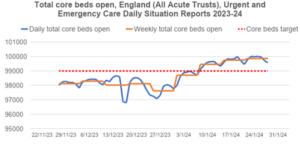Dear Ms Smyth,
Thank you for your letter of 1 February regarding recent official communications from the Department of Health and Social Care (DHSC) and NHS England on the delivery of hospital beds this winter.
On 25 January, DHSC posted on X:
“We’ve hit our target for 5,000 extra permanent hospital beds across the country this winter to help patients receive care faster”
with an infographic stating “5,000 extra hospital beds delivered this winter.”
The Secretary of State for Health and Social Care Rt Hon Victoria Atkins MP reposted this, adding:
“I want faster, simpler, fairer health care for all our patients. That’s why we’ve delivered 5,000 extra beds this winter to help cut waiting lists”.
The NHS England Urgent and Emergency Care (UEC) Plan was published in January 2023. As part of this plan, the NHS committed to “5,000 new beds as part of the permanent bed base for next winter” which was later referred to as “5,000 more staffed, sustainable beds in 2023-24”.
NHS England told us that ‘permanent’ here refers to what are categorised in the statistics as ‘core’ beds. It monitored the growth in core beds internally using the UEC Daily Situation Reports from 2022-23 that contained the split of core and escalation beds, and tracked changes from the April 2022 position of 94,502 core beds (from which the original target was set), leading to a target of 99,500. However, the breakdown of core and escalation beds is not currently presented in the published statistics prior to 20 November 2023. This means that it is not possible for the public to verify progress against the NHS England or DHSC news statements using data for the 2022-23 series. It would support greater transparency for the 2022-23 series to be retrospectively updated to include this breakdown.
In July 2023, an NHS England press release expressed a slightly different target – with a slightly smaller number to be achieved by a slightly earlier date:
“With high levels of bed occupancy all year around, hospitals are putting more beds in place for patients and are on track to hit 5,000 additional ‘core’ permanent general and acute beds. Thanks to the efforts of the NHS, more than 99,000 core beds will be in place across the country by December 2023 – thousands more than last year, to boost resilience”.
Published statistics from the UEC Daily Situation Reports 2023-24 (in the chart below) show that the highest number of core beds on any given day in December was 98,673 on 14 December, slightly shy of the more recent target. The number of core beds then exceeded 99,000 for the first time on 8 January and the original target of 99,500 on 10 January. The average number of core beds over the seven days from 15 to 21 January 2024 – immediately prior to the DHSC post – was 99,750. So, strictly speaking, the original target was met ahead of schedule and the subsequent one a few days behind schedule. DHSC could have spelt this (and the definition of ‘permanent’ beds) out more exhaustively, but on balance its communications were reasonable and not materially misleading, notwithstanding the desirability of greater transparency as to the original target, as above.
Source: Urgent and Emergency Care Daily Situation Reports 2023-24
Yours sincerely,
Sir Robert Chote
Chair

